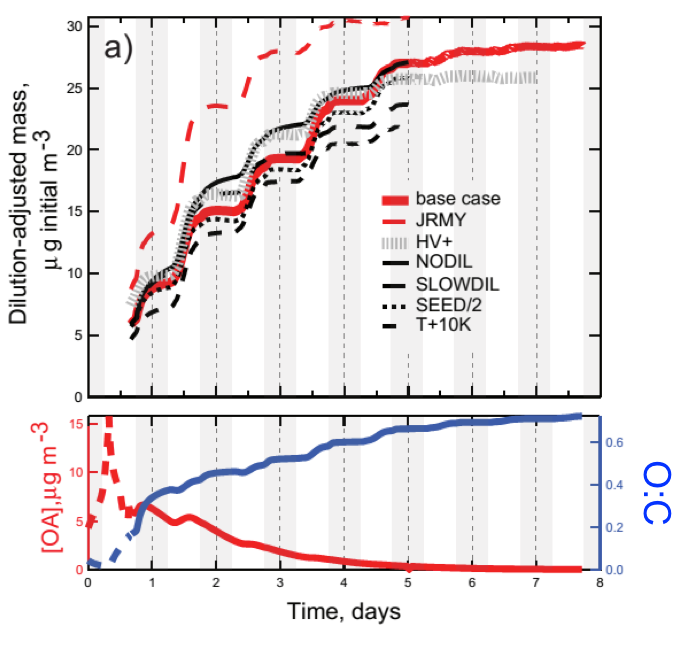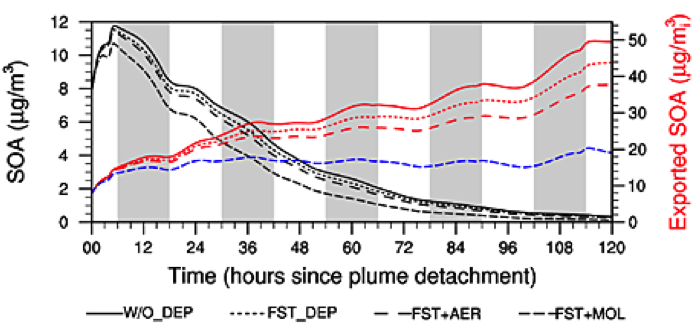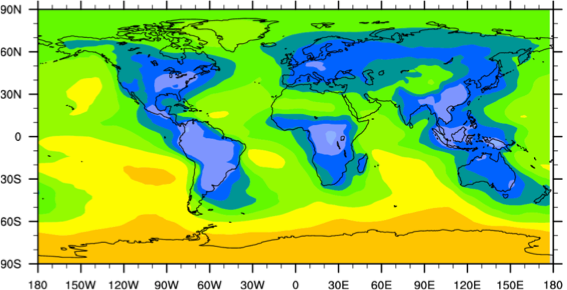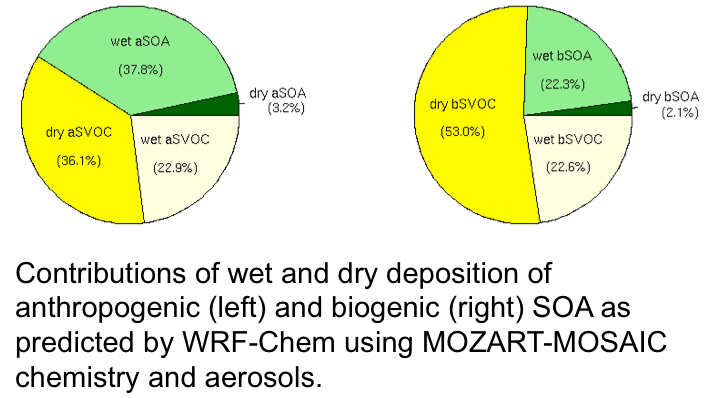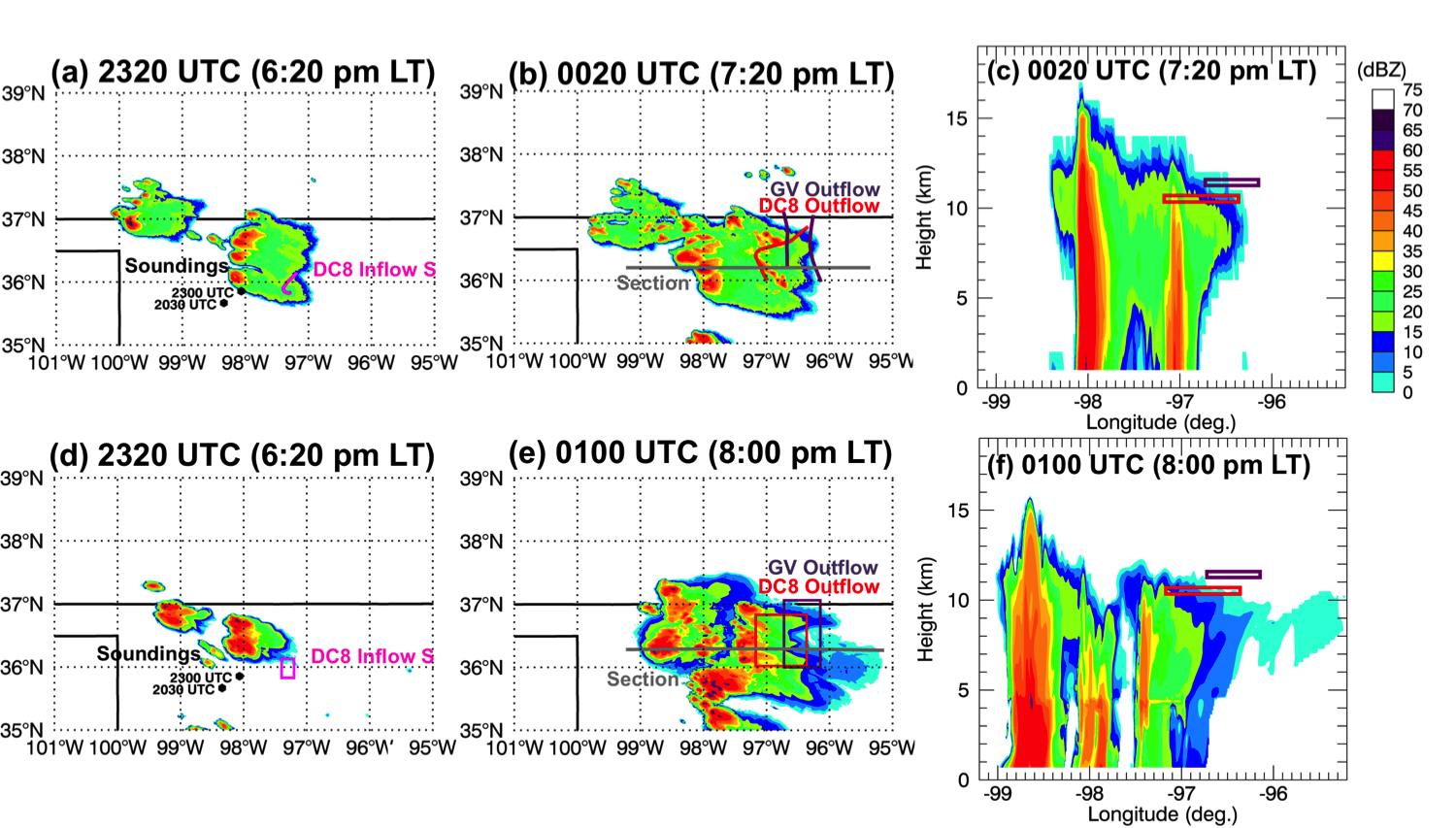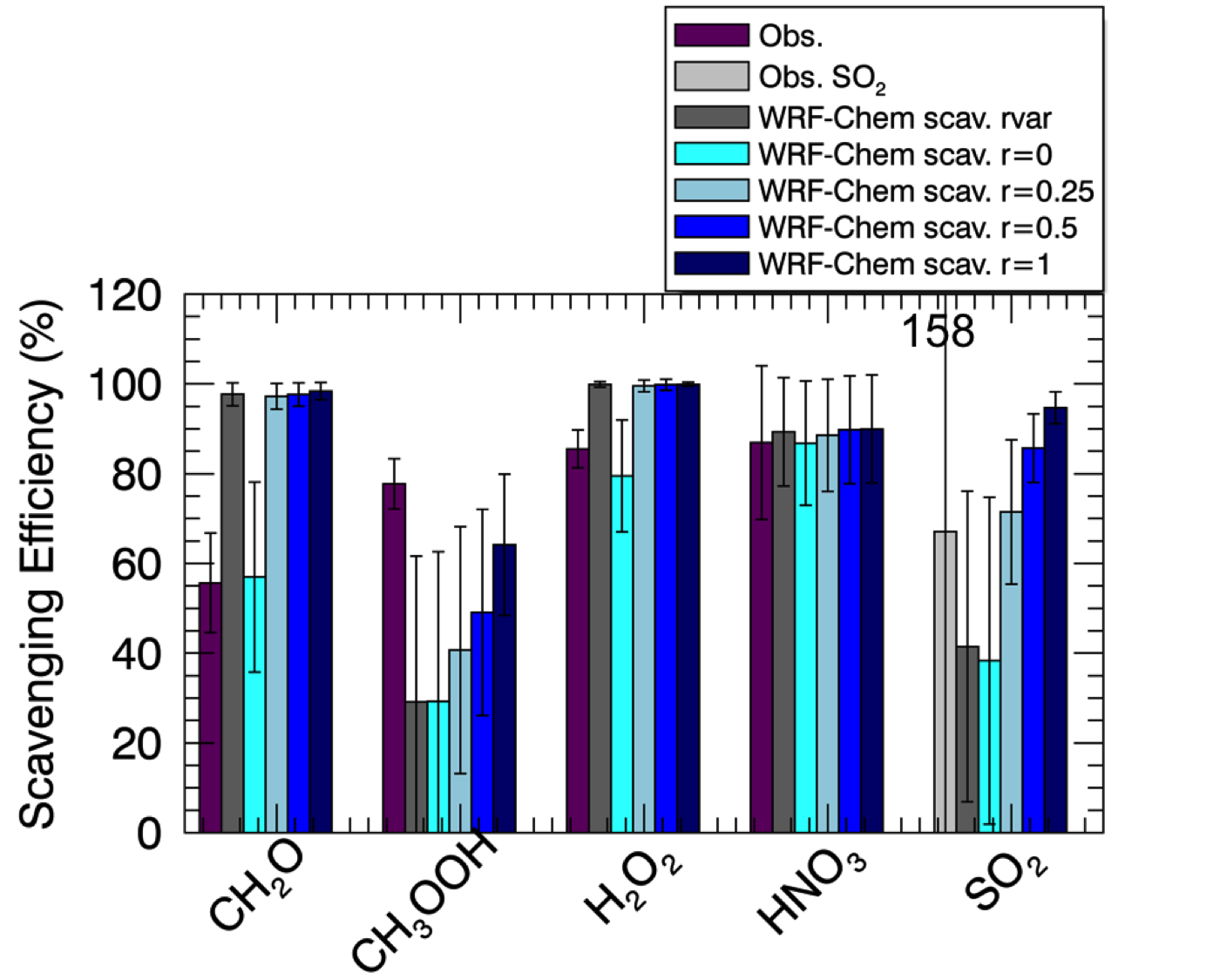Science
SOA lifecycle is more dynamic than previously thought
Organic aerosols are the dominant constituents of submicron aerosols worldwide, and yet our understanding of their atmospheric lifecycle is limited. Current regional-scale and global models fail to describe the observed amounts and properties of chemically formed secondary organic aerosols (SOA), leaving large uncertainties on the effects of aerosols on weather and human health.To improve model predictions, production and removal of SOA can be studied in detail with the 0-dimensional, self-generating gas-phase chemistry GECKO-A model.
|
|
PRODUCTION: The total mass (plume-integrated) of organic aerosol increases 5-fold during export from Mexico City (upper panel), regardless of various model assumptions (vapor pressure scheme, photolysis and temperature changes, dilution rates, seed amount), even as the local concentration decreases (lower panel).
Lee-Taylor et al., (2015) Atmos. Chem. Phys. |
|
REMOVAL: Dominant SOA removal pathways are particle evaporation when oxygenated gases are dry-deposited (top right) and particle fragmentation by photolysis (lower right). Other models limit SOA removal to rainout.
Hodzic et al. (2014) Geophys. Res. Lett. Hodzic et al. (2015) Atmos. Chem. Phys. |
|
WRF-Chem now includes updated production and removal of organic aerosols
Organic aerosols are the dominant constituents of submicron aerosols worldwide, and yet our understanding of their atmospheric lifecycle is limited. Current regional-scale and global models fail to describe the observed amounts and properties of chemically formed secondary organic aerosols (SOA), leaving large uncertainties on the effects of aerosols on weather and human health.
WRF-Chem model development, based on laboratory data and explicit chemical modeling with GECKO-A (Hodzic et al., 2014, ), has a more detailed gas-phase chemistry description of the SOA precursors isoprene, monoterpenes, methyl butanol, and glyoxal. Formation of organic aerosols account for the volatility and water solubility of organic compounds in both the gas and particle phases. The organic aerosols and their precursors are removed via CCN activation, washout, and dry deposition.
|
Dry Deposition of organic gases controls the amount of atmospheric SOA
Hodzic et al. (2014) Knote et al. (2015) Atmos. Chem. Phys. |
|
Computationally-fast SOA production scheme now in WRF-Chem
An empirical SOA production scheme (Hodzic and Jimenez, 2011) has been added for anthropogenic and biomass-burning sources with the MOZART-MOSAIC gas and aerosol chemistry. This computationally fast scheme is constrained from measurements. This model configuration is a suitable framework for applications that are focused on the transport of urban plumes (e.g. forecasting during field projects) and radiative effects of the total aerosol burden (e.g. regional Earth system studies) instead of the details of the SOA formation process.
South Asia air quality in 2050
High-resolution air quality simulations with the nested regional Earth system model coupled with chemistry (NRCM-Chem) are being done to quantify future changes in air quality over South Asia. By performing regional-scale simulations, several atmospheric processes (e.g. urban emissions, topographic effects and convection) relevant to air quality can be better represented than global chemistry-Earth system simulations. Thus, these simulations give much better information as to where air quality exceedences may occur. Three 10-year simulations, one present day conditions and two future scenarios bounding estimates of future emissions, have been performed for two domains.
Maximum daily 8-hour average (MDA8h) surface ozone from the outer domain range from 40-50 ppbv over the Gangetic Basin of India for present day conditions. Following the representative concentration pathway (RCP) 8.5 emissions scenario shows that MDA8h ozone will increase by ~10 ppbv for the Gangetic Basin, while following RCP 6.0 emissions scenario will cause little change to MDA8h ozone. The projected increased ozone suggests that northern India will frequently exceed the India National Ambient Air Quality Standard of 50 ppbv.
Similarly, 24-h average surface particulate matter < 2.5 μm in size (PM2.5, the size aerosols that most deeply penetrate into the respiratory system) will also increase substantially over India following the RCP 8.5 scenario, but change only a little following RCP 6.0 scenario compared to present day PM2.5 concentrations. However, present day and both future model projections predict PM2.5 concentrations greater than the India National Ambient Air Quality Standard of 40 μg m-3 for northern India.
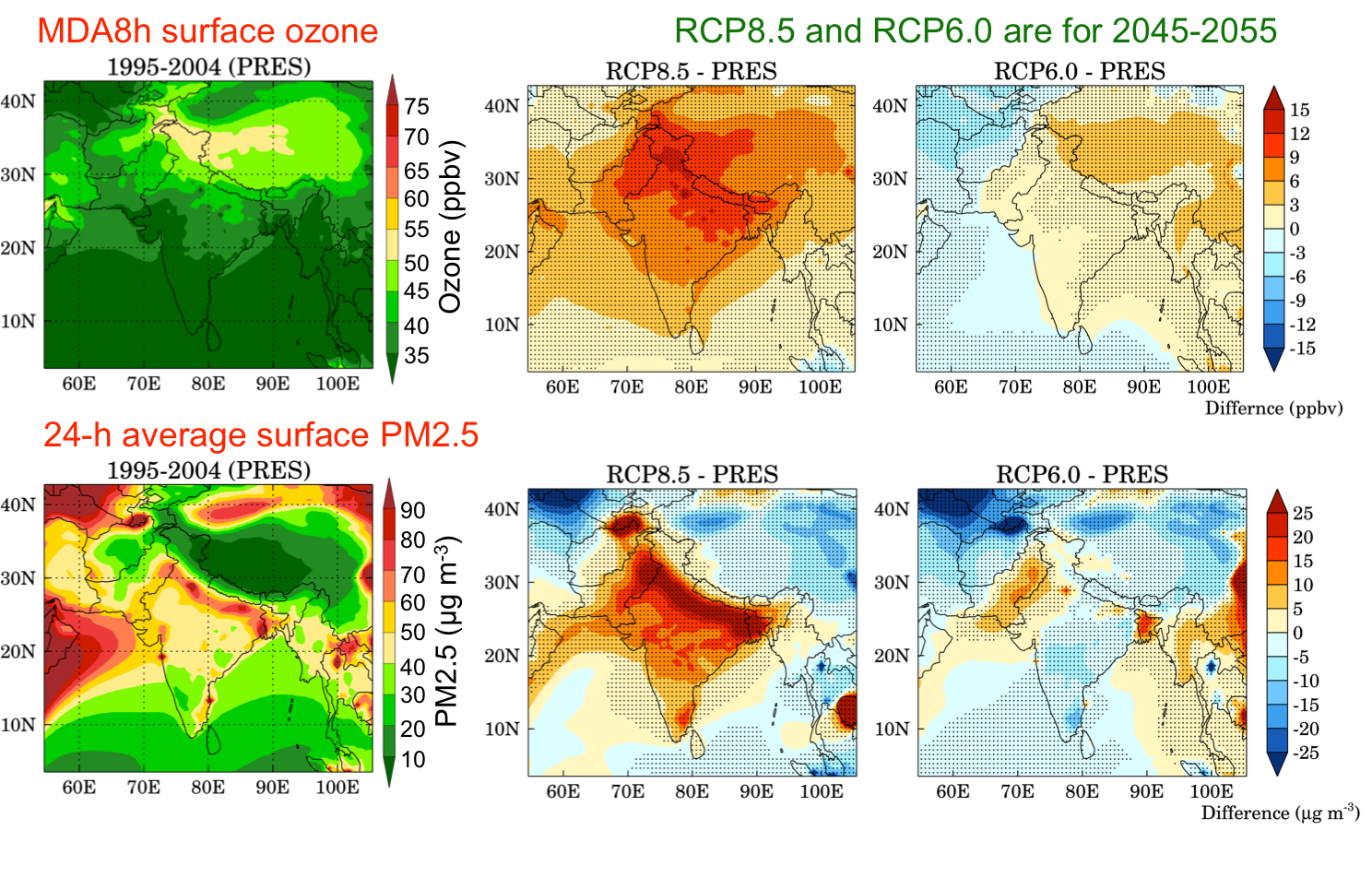
Top panels: NRCM-Chem results of maximum daily 8-h average (MDA8h), annually averaged surface ozone for present day (1995-2004, left panel) and changes in MDA8h ozone between future (2045-2055) and present day following the RCP 8.5 scenario (middle) and RCP 6.0 scenario (right panel). Bottom panels: NRCM-Chem results of 24-h averaged, annually-averaged surface PM2.5 for present day (1995-2004, left panel) and changes in surface PM2.5 between future (2045-2055) and present day following the RCP 8.5 scenario (middle) and RCP 6.0 scenario (right panel).
These simulations have been supported by the NCAR Strategic Capability Project granted by NCAR/CISL.
WRF-Chem simulations of thunderstorms and chemistry
The ability of WRF-Chem to represent wet scavenging of trace gases is being evaluated using observations from the Deep Convective Clouds and Chemistry (DC3) Field Campaign. The 29 May 2012 severe storm in northern Oklahoma is simulated with WRF-Chem using a grid spacing of 1 km in the horizontal and 90 vertical levels from the surface to 50 hPa. Removal of soluble trace gases, e.g. nitric acid, sulfur dioxide, formaldehyde, hydrogen peroxide, and methyl hydrogen peroxide, is parameterized using the Neu and Prather (2012) scheme.
| WRF-Chem simulates the storm location, size, and structure of the 29 May storm |
Column-maximum radar reflectivity (dBZ) and east-west vertical cross-section of reflectivity from NEXRAD observations (upper panels) and WRF-Chem (lower panels). Regions where the aircraft sampled the composition of the inflow air (magenta) and outflow air (red and black) are marked.
|
|
Scavenging efficiencies of soluble species for the Oklahoma May 29-30 storm as derived from observations in the inflow and outflow regions of the storm and from the ve WRF-Chem simulations with scavenging. The fraction r of trace gas retained in freezing cloud and rain water is varied in different simulations showing the sensitivity of the trace gas to this process. |
The simulated scavenging efficiencies are sensitive to how much of the trace gas is retained in a frozen cloud particle (when cloud drops freeze).
Bela et al. (2016) J. Geophys. Res. |
REACCTING
Research of the Emissions, Air Quality, Climate and Cooking Technologies in Northern Ghana
According to recent reports, nearly three billion people in the developing world cook food and heat their homes with open fires or cookstoves that are fueled by solid biofuels. The smoke exposure from these activities is estimated to lead to approximately four million premature deaths each year. The emissions from these processes also add significantly to global emissions of greenhouse gases, short-lived Earth system forcers, and air pollutants. However, emission estimates from these processes, and their atmospheric impacts, are still highly uncertain. Furthermore, stove technologies exist that enable reductions in the amount of fuel used for cooking, and in emissions. Yet, the extent to which these technologies will be utilized, change emissions, and impact health and atmospheric composition is unclear.
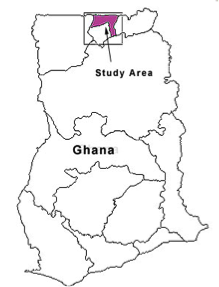
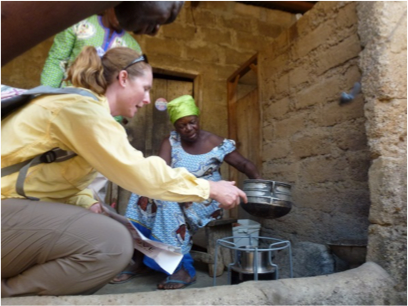
Dickinson et al. (2015) BMC Public Health, 10.1186/s12889-015-1414-1
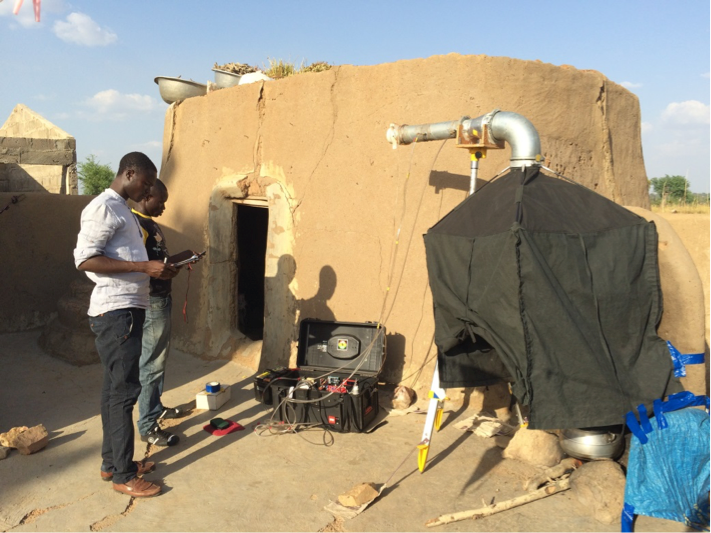
Additional work is being pursued to improve our estimates of anthropogenic emissions from the African continent so that atmospheric chemistry and Earth system modeling in the region of the globe can be more successful. Led by Eloise Marais (Harvard University), estimates of key emission sources are being estimated for 2006 and 2013.
Improving Air Quality, Health and the Environment Through Household Energy Interventions in the Tibetan Plateau
Domestic combustion of biomass and coal for cooking and heating purposes is a major contributor to ambient pollution in China, with serious consequences for public health. Improved cookstoves are developed to mitigate emissions from this sector; however, great uncertainties still exist both for the baseline emissions from traditional cooking and heating activities, and to what extent the newly developed technologies are an improvement. To tackle these problems, a multi-disciplinary energy intervention study is being conducted in Sichuan, China, to better understand current household energy usage, emissions before and after installation of new cookstove technology, and personal exposure of study participants. As part of this study, NCAR/ACOM scientists are conducting regional model studies using the Weather Research and Forecasting model with Chemistry (WRF-Chem) to quantify the impact of residential cooking and heating emissions on regional air quality and human health. Model output is evaluated against surface air quality measurements across China, and applied to exposure-response relationships between ambient fine particulate pollution (PM2.5) and cardiopulmonary health outcomes. Residential emissions are responsible for nearly half of the premature deaths from PM2.5 from all emission sources, and emissions from heating alone are found to be very important, although this is a source often not considered for emission reduction.
This work is funded by the US EPA STAR Grant # R835422
